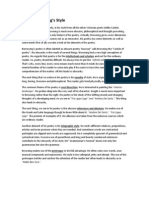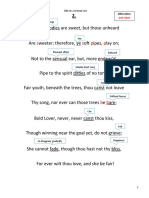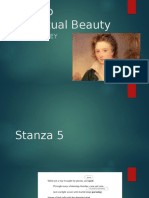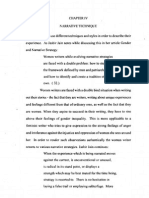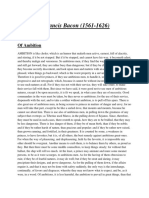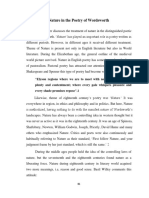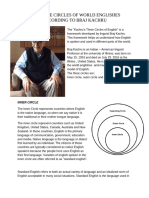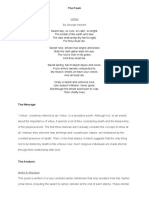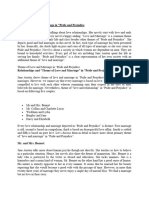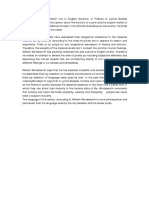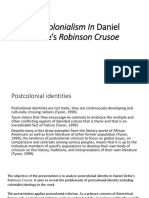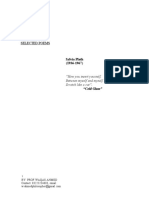0 ratings0% found this document useful (0 votes)
210 viewsThe Salient Features of Jane Austen
The Salient Features of Jane Austen
Uploaded by
CELL IELTSThis document provides an overview and analysis of Jane Austen's writing style and themes. It discusses her as a realist who drew from everyday life. Her novels primarily focus on matrimony and courtship. She uses subtle irony and humor to expose the flaws in her characters. Her character portrayals, especially of women, are insightful but limited in scope due to focusing on a narrow slice of society. Overall, the document analyzes Austen's talents at capturing truthful human nature and interactions within the confined world she observed.
Copyright:
© All Rights Reserved
Available Formats
Download as DOCX, PDF, TXT or read online from Scribd
The Salient Features of Jane Austen
The Salient Features of Jane Austen
Uploaded by
CELL IELTS0 ratings0% found this document useful (0 votes)
210 views10 pagesThis document provides an overview and analysis of Jane Austen's writing style and themes. It discusses her as a realist who drew from everyday life. Her novels primarily focus on matrimony and courtship. She uses subtle irony and humor to expose the flaws in her characters. Her character portrayals, especially of women, are insightful but limited in scope due to focusing on a narrow slice of society. Overall, the document analyzes Austen's talents at capturing truthful human nature and interactions within the confined world she observed.
Original Description:
novel
Copyright
© © All Rights Reserved
Available Formats
DOCX, PDF, TXT or read online from Scribd
Share this document
Did you find this document useful?
Is this content inappropriate?
This document provides an overview and analysis of Jane Austen's writing style and themes. It discusses her as a realist who drew from everyday life. Her novels primarily focus on matrimony and courtship. She uses subtle irony and humor to expose the flaws in her characters. Her character portrayals, especially of women, are insightful but limited in scope due to focusing on a narrow slice of society. Overall, the document analyzes Austen's talents at capturing truthful human nature and interactions within the confined world she observed.
Copyright:
© All Rights Reserved
Available Formats
Download as DOCX, PDF, TXT or read online from Scribd
Download as docx, pdf, or txt
0 ratings0% found this document useful (0 votes)
210 views10 pagesThe Salient Features of Jane Austen
The Salient Features of Jane Austen
Uploaded by
CELL IELTSThis document provides an overview and analysis of Jane Austen's writing style and themes. It discusses her as a realist who drew from everyday life. Her novels primarily focus on matrimony and courtship. She uses subtle irony and humor to expose the flaws in her characters. Her character portrayals, especially of women, are insightful but limited in scope due to focusing on a narrow slice of society. Overall, the document analyzes Austen's talents at capturing truthful human nature and interactions within the confined world she observed.
Copyright:
© All Rights Reserved
Available Formats
Download as DOCX, PDF, TXT or read online from Scribd
Download as docx, pdf, or txt
You are on page 1of 10
The Salient Features of Jane
Austen’s Fiction
November 6, 2010 neoenglish MA English-Literature
Not Among the Greatest of the Novelists
Jane Austen occupies a high rank among English novelists, though
she is certainly not one of the greatest of them. Her chief
characteristics as a novelist are as follows:
A Realist
She is a realist who draws her materials from actual life as she sees
it. Her stories are perfectly credible and convincing. There is nothing
fantastic, fanciful, or far-fetched in them. She depicts the social life of
her time and is thus a practitioner of the domestic novel or the novel
of manners. Realism is the keynote of her novels whether they are
considered from the point of view of story, characters, or setting.
Matrimony, Her Principal Theme
The principal theme of her novels is matrimony. She is pre-
occupied with the business of making matches for her heroines.
Generally, the heroine, after a few false starts, meets the right man,
and a series of misunderstandings and frustrations occur to delay but
never to prevent their union. Morning calls, dinner parties, dances,
shopping expeditions, weddings, etc., are the principal ingredients of
her stories.
Her Humour and Irony
Jane Austen is a humorist whose favourite weapon is irony. Irony
is her forte and most of the humour proceeds from her use of it. Her
novels are all comedies in which she exposes the absurdities and
failings of her characters. She has a comedian’s attitude to life, and her
vision is ironical and satirical. However, her humour is not of the
boisterous type; it is a mild and subdued kind of humour. It may be
noted also that there is little malice in her attitude, though a note of
bitterness occasionally creeps into it. Her humour has been compared
to that of Shakespeare, but that is an exaggeration.
Character-Portrayal
She gives us an abundance of character-portraits. She shows an
acute grasp of the human mind and human motives, and reveals these
with great skill. She is not only concerned with the externals of
character, but also with a psychological portrayal of it. Her studies of
women are more successful than those of men. Another noteworthy
feature about these novels is that there are neither any perfect or
idealized characters nor any thorough villains in them.
Few Dramatic or Melodramatic Incidents
There are few dramatic or melodramatic incidents in her stories.
Her exquisite touch renders commonplace things and characters
interesting by virtue of the truth of description and the truth of
sentiment. She is not interested in the paraphernalia of the “romantic”
novel. Nor does she show any capacity to depict “passion”. There are
no fiery outbursts in her stories, and no dwelling upon the passion of
love. Nor do we have many tragic or heart-rending or deeply poignant
situations to grieve us. She deals principally with the comic side of life,
not its painful side.
Her Detachment
Her narration shows a remarkable detachment or objectivity on her
part. She does not interrupt her stories with her personal comments
(as Thackeray and George Eliot often do). She does not obtrude herself
on the reader’s attention, and her novels are free from intrusions by
her. Nor is there any moralizing in her stories. A moral purpose is
certainly there, but the reader is allowed to reach it by his own effort.
Her Limited Range
As her stories are based on her personal experience and an
observation of the life around her, her range is extremely limited. She
deals with a narrow mode of existence, and does not even show much
interest in external nature. She excludes much of human life from her
novels, because she does not have imagination enough to carry her
beyond her own observation. But within her narrow range she is
supreme. Her characters are true to life, and all her work has the
perfection of a miniature painting.
LOUIS CAZAMIAN’S VIEW OF JANE AUSTEN
A Limited Outlook
The novels of Jane Austen deal almost wholly with the restricted
circle of home life, and round it all social interests are gathered. The
atmosphere is one of provincial calm with a very limited outlook,
where the extremes of wealth and poverty are unknown. We find
ourselves in a small world of country gentry, clergymen, and middle-
class people, where social intercourse is smooth and simple. There are
few incidents which can be called dramatic, although our attention is
focused on shades of character. Jane Austen’s realism is more truly
psychological than that of Richardson, for it is free from the tragic
obsessions of a moral conscience. There is an extraordinary degree of
truth in her pictures of reality. Each of her novels depicts a group of
human beings, their relations with one another, their clashes and
affinities, their mutual influences, and their conversations.
Her Understanding of the Human Character
Jane Austen shows an intuitive understanding of human character.
Her intuition is so natural and supple that it appears absolutely
simple. She reads the inner minds of her characters as if those minds
were transparent. She seizes them in their depths. The secret
complexities of self-love, the many vanities, the imperceptible
quiverings of selfishness, are all indicated or suggested so calmly and
with so sober a touch that the author’s personal reaction is reduced to
a minimum. Her stories are perfectly objective and show a spirit of
gentle tolerance, though a subtle suggestion of irony hovers over every
page and reveals a sharpness of vision that could be extremely severe.
The Spirit of Classicism
There is little sentimentality in her novels which show a delicacy of
touch, a sense of balance, and a serene reasonableness. These novels
reflect the spirit of classicism in its highest form and in its most
essential quality. They show a safe, orderly harmony in the writer’s
mind, a harmony where the intellect is supreme. So classical is her
method that we are strongly reminded of the art of the great French
analysts. She writes in a manner that shows her aloofness from the
Romanticism which had spread its power around her. One of her first
novels, Northanger Abbey, is a most penetrating criticism of the self-
deception practised by those whose souls are intoxicated with the spell
of artificial fear. Her attitude towards Romanticism became less
critical with the passing of time.
In Mansfield Park and Persuasion there is a warming of the thought,
a greater tenderness of feeling, and an easier reconciliation with the
spirit of her times. She is not in complete agreement with the
hierarchy of the social order, but she does not give any signs of revolt.
Her moral teaching is characterized by a wisdom which is free from all
illusions. Her moral teaching is the fruit of a perfectly healthy heart
and mind.
The Delineation of Women
Her novels contain a wealth of character studies. These character
studies are not all equally good. Her studies of women are more
searching and more life-like than those of men. She has delineated
character from the inside with the full and finished touch of the great
masters; and she can also sketch figures with so sure and suggestive a
pen that they stand out on a strong and unforgettable ground. Her
power of perception is keen and fresh. She immediately grasps the
individual traits, the odd as well as the comic. Her work represents in
an original way the internal comedy of life with all its whims and
fancies. Reality awakens in her a spirit of amusement without
bitterness. Her grasp of character does not destroy the concrete sense
of faces, gestures, and acts. She abundantly possesses the implicit
eloquence of humour.
A Unique Charm
Her range of effects is wonderfully varied. Pride and
Prejudice shows a piquant, youthful gaiety. Her art here is almost
perfect. Her last novels show a mellow maturity, though a less sure art.
They are less free from lengthy or weak passages, but are richer in
moral significance. But all the novels possess a unique charm
associated with a most sober distinction of technique and style.
SOME OTHER OPINIONS ABOUT JANE AUSTEN
1. The Truth of the Description and the
Sentiment in Her Novels
“That young lady had a talent for describing the involvements,
feelings, and characters of ordinary life which is to me the most
wonderful thing I have ever met with. The big bow-wow I can do
myself like anyone going, but the exquisite touch which renders
commonplace things and characters interesting from the truth of the
description and the sentiment is denied me.—Sir Walter Scott.
2. Unequalled Within Her Own Field
Very few English writers ever had so narrow a field of work as Jane
Austen. Like the French novelists, whose success seems to lie in
choosing the tiny field that they know best, her works have an
exquisite perfection that is lacking in most of our writers of fiction.
With the exception of an occasional visit to the watering-place of Bath,
her whole life was spent in small country parishes, whose simple
country people became the characters of her novels. Her brothers were
in the navy, and so naval officers furnished the only exciting element
in her stories; but even these alleged heroes lay aside their imposing
martial ways and act like themselves and other people. Such was her
literary field, in which the chief duties were of the household, the chief
pleasures in country gatherings, and the chief interests in matrimony.
Life, with its mighty interests, its passions, ambitions, and tragic
struggles swept by like a great river; while the secluded interests of a
country parish went round and round quietly. We can easily
understand, therefore, the limitations of Jane Austen; but within her
own field she is unequalled. Her characters are absolutely true to life,
and all her work has the perfection of a miniature painting. The most
widely read of her novels is Pride and Prejudice: but three
others, Sense and Sensibility, Emma, and Mansfield Park, have slowly
won their way to the front rank of fiction. From a literary view-
point Northanger Abbey is perhaps the best; for in it we find that
touch of humour and delicate satire with which this gentle little
woman combated the grotesque popular novels of the Udolpho type.—
William J. Long.
3. Her Realism
The area of experience with which she could deal was naturally
determined by her own life. She has been said to hold a mirror up to
life and it is apparent to any reader of her letters that she mirrors the
life she knew. The family names –Marianne, Anne, Henry; the family
professions — the church, the militia, the navy, landowning; the family
gatherings, journeys, walks; the countryside she knew; the streets of
Bath and Lyme; the conventions and the manners of her time are all
recorded. But we must remember that the mirror is not a true one — it
is deflected by her own outlook as moralist and ironist.
Character-Analysis
Her interest is in human motive, the reactions of individuals to
each other; and therefore a narrow social setting was ideal material for
her. The small area of experience allowed closer analysis of recurring
situations and types; she could deal with them with absolute accuracy
by never stepping beyond the limits of her personal knowledge.
No Strong Passions
Charlotte Bronte said that the passions were perfectly unknown to
Jane Austen. Certainly the surface of the novels does not immediately
suggest strong passions. Jane Austen, in choosing to delineate as
accurately as possible the life she knew, recognized that life was not
likely to include mad wives, French mistresses, orphans and the rest of
the paraphernalia of the romantic novel. Her prime belief that one
should come to terms with the reality of life, that one should deal only
with what was probable, is as much part of her first published
novel, Sense and Sensibility, as it is of Emma. And since her settings
are the drawing-rooms, ball-rooms, parks and gardens of a civilized,
leisured class, she was unlikely to introduce lunatics, villains, or
ghostly figures.
Her Limitations
As a novelist, Jane Austen works within strict limitations. This is
often put forward as a criticism of her work. It has been said, for
example, that she had only one plot, that her subject- matter is
limited, superficial, repetitive, and without any real seriousness or
relevance to life. Certain limitations were imposed upon her by the
conventions of the romantic novel, whose plot demanded that she
should deal with the courtship and marriage of her heroine. But she
herself claimed that she worked on a “little bit (two inches wide) of
ivory”. She was conscious of her limitations, worked strictly within
them, and turned them to her adavntage.– Norman Sherry
4. The Comic Spirit
Two-thirds of her dramatis personae are regular comic character-
parts. And even those figures with whom she is most in sympathy,
even her heroines, are almost all touched with the comic spirit. Two of
them, Emma and Elizabeth Bennet, are a great deal cleverer than most
heroines of fiction; one of them, Anne Elliot, is very good. But all three
are flesh and blood workaday creatures, able to laugh, if not to be
laughed at.
Living Characters
She possesses in the highest degree the one essential gift of a
novelist, the power to create living characters. It is true that she only
draws them in their private aspect, but this is not a superficial aspect.
A man’s relation to his wife and children is at least as important a part
of his life as his relation to his beliefs and career, and reveals him as
fundamentally. Indeed, it reveals his moral side more fundamentally.
If we want to know about a man’s talents, we should see him in
society; if we want to know about his temper, we should see him at
home. Furthermore, Jane Austen shows man as a rule not in moments
of crisis but in the trivial incidents of every day. After all, life is made
up of little things, and human nature reveals itself in them as fully as
in big ones. A picnic shows up selfishness, kindness, vanity, sincerity,
as much as a battle. Only we must have the faculty to perceive them.
Jane Austen had this faculty. Not Dickens himself can visualise
outward idiosyncrasies of his creatures more vividly, their manner,
their charm, their tricks of speech. But she does not have to present
man involved in major catastrophes. However, if her plot demands it,
she shows adequate capacity for portraying her characters in moments
of serious crisis. Lousia Musgrove, skipping down the steps of the
Cobb at Lyme, stumbles and falls apparently lifeless. With acute
insight Jane Austen illustrates the way the rest of the party react to
this disaster: how the egotistic Mary Musgrove is absorbed in her
egotistic agitation, how the unrestrained Henrietta collapses, how
Wentworth’s sympathetic imagination pictures at once the effect of the
news on Louisa’s parents, how Anne alone, unselfish, self-controlled,
keeps her presence of mind. But though we admire Jane Austen’s
insight, it tells us nothing new about these people. The uneventful
walks and dinner-parties where we have already seen them have
already revealed their temperaments and natures to us.
— Lord David Cecil
5. Her Finely Etched Pictures of Social Life
In the daily routine of visits, shopping, sewing, gossip, and other
trivial matters which are regarded with an easy liveliness in her letters,
Jane Austen found the raw material of her novels. The world which
her books present to us is essentially an eighteenth-century world in
its habits, tastes, and appearance. She wrote just before the Industrial
Revolution changed for the worse so much of the face of England, and
the clean stillness of her country-towns, the unspoiled beauty of her
countryside with its well-kept estates and cheerful farms, provide a
perfect background to her finely etched pictures of social life. There is
a luminous clarity about her style as well as about the scenes she
portrays. She was describing, though she did not know it, the last
generation of Englishmen and Englishwomen who could face life with
cheerfulness, decorum, and determination to go through the
appropriate motions with grace, elegance, and enjoyment. This is
neither romanticism nor sentimentality but she shows a remarkable
insight into the relation between social convention and individual
temperament.
Her Deliberately Restricted Scope
It has often been remarked that, although the Napoleonic Wars
were going on throughout Jane Austen’s writing career, she keeps
mention of them out of her novels, in which soldiers appear only as
attractions for the girls or in some similar social capacity. This is a
tribute not to her narrowness, but to the calm accuracy with which she
saw her subject. In the days when wars were fought by small
professional armies, the impact of the fighting on the daily life of
people living in small country-towns was negligible, and it would have
unrealistic as well as artistically inappropriate for Jane Austen to have
expanded her horizon to include discussions of world-affairs which
were not relevant to the situations she was presenting. She worked
deftly and wittily, and restricted her scope deliberately because her
intention was—miscrocosmic—to create a world in little, perfectly
proportioned and shown in the liveliest detail, and an accurate model
of the total social world of which this was only a small part. —
David Daiches
6. Vicious Men in her Novels
Jane Austen knew that vicious men existed, and frequently
flourished. Wick-ham, Willoughby, and Crawford are all seducers, but
she warns us that we must not look for the satisfaction of seeing them
ruined. Of Willoughby she expressly says: “That he was for ever
inconsolable, that he fled from society, or contracted a habitual gloom
of temper, or died of a broken heart, must not be depended on, for he
did neither. He lived to exert, and frequently to enjoy himself.” Each
had at some stage a prospect of gaining the heroine’s affections, and
each failed: Elizabeth looked first for Wickham at Netherfield ball;
Fanny was softening towards a reformed Crawford; Willoughby held
Marianne’s heart in his hand. Their real crime is that they do not know
a good thing when they see it, and their punishment is that they miss
their chance. And they do not care a bit. Frank Churchill, prepared to
risk Emma’s happiness to provide cover for his own, is let off with
mere strictures; and Mr. Woodhouse, gentlest of rebukers, sums him
up as “not quite the thing”. Mr. Woodhouse may not be formidable,
but his disapproval is.
7. The Reputation of Jane Austen
Jane Austen’s literary reputation established itself unobtrusively
but steadily. Within her own generation she obtained recognition.
Scott was among her earliest and most spontaneous admirers; but, to
the generation that followed, her novels necessarily appeared old-
fashioned: the very language belonged to the past century. Macaulay’s
enthusiasm, when he likened her to Shakespeare and Moliere, was
premature, and perhaps unguarded. Other writers, from Southey to
Henry James, have been content to cherish a private appreciation of
her art. General approbation grew, however, until in 1910 E.V. Lucas
called her “an English classic”. Since A.C. Bradley recalled critical
attention to the peculiar quality of her genius (in 1911), her standing as
a novelist has not been seriously challenged; detraction has fastened
on her character, alleging that her apprehension was dull, her
temperament cold, her mind and heart narrow — despite the contrary
witness of biographical accounts based on personal recollection or
family tradition. Appreciation of the moral sensibility and seriousness
discoverable in her novels has lately advanced, at some cost to the
enjoyment of her wit. — Mary Lascelles
You might also like
- Dungeon Command CompleteDocument12 pagesDungeon Command CompleteazurecobaltNo ratings yet
- Suicide in Hamlet by William Shakespeare PDFDocument3 pagesSuicide in Hamlet by William Shakespeare PDFVirág KovácsNo ratings yet
- (Penguin Active Reading) Joseph Sheridan Le Fanu - Carmilla-PenguinDocument57 pages(Penguin Active Reading) Joseph Sheridan Le Fanu - Carmilla-Penguinfor jstor100% (2)
- Jane Austen's Contribution To English NovelDocument3 pagesJane Austen's Contribution To English NovelFaisal JahangeerNo ratings yet
- Pride and Prejudice-Jane Austen: TH THDocument2 pagesPride and Prejudice-Jane Austen: TH THIoana ButiuNo ratings yet
- Preface To Shakespeare - II NotesDocument21 pagesPreface To Shakespeare - II NotesUbaid Ur rahmanNo ratings yet
- Ahmed Ali A WriterDocument7 pagesAhmed Ali A WriterjiaNo ratings yet
- Literary Characteristics of Puritan AgeDocument16 pagesLiterary Characteristics of Puritan AgeMaria Rani100% (1)
- 1 William Wordsworth - Lucy PoemsDocument4 pages1 William Wordsworth - Lucy Poemstijana sladoje100% (1)
- BrowningDocument3 pagesBrowningKiran AnjumNo ratings yet
- 11 2 ET V1 S1 - Introduction PDFDocument12 pages11 2 ET V1 S1 - Introduction PDFshahbaz jokhioNo ratings yet
- Comment On The Title of The NovelDocument7 pagesComment On The Title of The Novelnarendran kNo ratings yet
- 2 Stanza Ode To A Grecian UrnDocument6 pages2 Stanza Ode To A Grecian UrnHudda FayyazNo ratings yet
- " Thou Hast Made Me, and Shall Thy Work Decay?Document2 pages" Thou Hast Made Me, and Shall Thy Work Decay?Sbgacc SojitraNo ratings yet
- Wordsworth and ColeridgeDocument7 pagesWordsworth and ColeridgeAqeel SarganaNo ratings yet
- Cracking India Tells The Story of The Partition ofDocument7 pagesCracking India Tells The Story of The Partition ofmarviNo ratings yet
- KeatsDocument3 pagesKeatsSandeep StephenNo ratings yet
- Hymn To Intellectual Beauty 3Document19 pagesHymn To Intellectual Beauty 3shahanaNo ratings yet
- Traits of Charles Lamb EssaysDocument3 pagesTraits of Charles Lamb EssaysDaffodilNo ratings yet
- 09 Chapter4 PDFDocument87 pages09 Chapter4 PDFTaibur RahamanNo ratings yet
- The Squire CharacterDocument2 pagesThe Squire Charactermanazar hussainNo ratings yet
- Mark On The WallShort Essay Type and Short Type Questions With AnswersDocument4 pagesMark On The WallShort Essay Type and Short Type Questions With Answersanmoni666No ratings yet
- William Blake BiografyDocument2 pagesWilliam Blake BiografyMariana DiaconuNo ratings yet
- The Love Song of J.Alfred Prufrock - 5-2 MARKSDocument5 pagesThe Love Song of J.Alfred Prufrock - 5-2 MARKSthexgrind683No ratings yet
- English Tintern AbbeyDocument29 pagesEnglish Tintern AbbeyJagruti Nirav100% (1)
- Acfrogazaje74gcyeglc4xqsaswjm847dqttjpz Evdto0ubgyg9bs10jyx2prpvnq1gc 5lak8hjzqcr - Virdgtzgpzyjs6kdhs 4l0z Sttyqhhu1scm38ducjqvizbckkndckwkyjqoku4mmDocument20 pagesAcfrogazaje74gcyeglc4xqsaswjm847dqttjpz Evdto0ubgyg9bs10jyx2prpvnq1gc 5lak8hjzqcr - Virdgtzgpzyjs6kdhs 4l0z Sttyqhhu1scm38ducjqvizbckkndckwkyjqoku4mmNiroj HassanNo ratings yet
- The Dreamers (Play) - WikipediaDocument5 pagesThe Dreamers (Play) - WikipediaZareesh KhanNo ratings yet
- The Art of The Essayist Exam Note AllDocument7 pagesThe Art of The Essayist Exam Note Allpopos86897100% (1)
- Lucy PoemsDocument2 pagesLucy PoemsMarija2803No ratings yet
- Essays of Francis BaconDocument4 pagesEssays of Francis BaconAradhana YadavNo ratings yet
- P.B. Shelley and John Keats: A Comparative AnalysisDocument5 pagesP.B. Shelley and John Keats: A Comparative AnalysisSaimin100% (1)
- Browning's Treatment of LoveDocument1 pageBrowning's Treatment of Loveparthaps150% (2)
- The Scarlet Letter: Identity Theme inDocument2 pagesThe Scarlet Letter: Identity Theme inIoana MunteanuNo ratings yet
- Prose of The Age of PopeDocument1 pageProse of The Age of PopeTehneat Arshad0% (1)
- Ted N ViolenceDocument3 pagesTed N ViolenceSameera JarralNo ratings yet
- Sonnet 18 Summary: First QuatrainDocument5 pagesSonnet 18 Summary: First QuatrainKhushi MehtaNo ratings yet
- The Scholar GypsyDocument8 pagesThe Scholar GypsyVaralakshmi VaralakshmiNo ratings yet
- Nature in The Poetry of WordsworthDocument32 pagesNature in The Poetry of Wordsworthjihoon's littlepout100% (1)
- Evaluate The Characteristics of Victorian PoetryDocument5 pagesEvaluate The Characteristics of Victorian PoetryMohammad Jahidul IslamNo ratings yet
- The Three Circles of World EnglishesDocument2 pagesThe Three Circles of World EnglishesKasandra Claire NaingueNo ratings yet
- Biography of Thomas HardyDocument2 pagesBiography of Thomas Hardyrosmery15No ratings yet
- A Modern TragedyDocument2 pagesA Modern TragedySaleem RazaNo ratings yet
- Fancy and ImaginationDocument16 pagesFancy and ImaginationHimanshu GoelNo ratings yet
- The Pot of GoldDocument15 pagesThe Pot of GoldKrishna MukherjeeNo ratings yet
- Discuss Hughes' Use of Dreams and Occult SymbolismDocument16 pagesDiscuss Hughes' Use of Dreams and Occult SymbolismJimmi KhanNo ratings yet
- Samus Heany by Saqib JanjuaDocument7 pagesSamus Heany by Saqib JanjuaMuhammad Ali SaqibNo ratings yet
- The Poem - VirtueDocument6 pagesThe Poem - VirtueTapi SkNo ratings yet
- Honest Criticism and Sensitive Appreciation Is Directed Not Upon The Poet But Upon The Poetry.Document6 pagesHonest Criticism and Sensitive Appreciation Is Directed Not Upon The Poet But Upon The Poetry.Jimmi KhanNo ratings yet
- A Dialogue of Self and SoulDocument4 pagesA Dialogue of Self and SoulAwais TareqNo ratings yet
- Assignment (Art For Art's Sake and Art For Life's Sake)Document6 pagesAssignment (Art For Art's Sake and Art For Life's Sake)Muhammad Asif BabarNo ratings yet
- Characteristics of Romantic RevivalDocument4 pagesCharacteristics of Romantic Revivalgohilharsh0451No ratings yet
- Theme of Love and Marriage inDocument3 pagesTheme of Love and Marriage infatimasrwr908No ratings yet
- DickinsonDocument4 pagesDickinsonAnna Maracine100% (1)
- EcstasyDocument5 pagesEcstasyanmansariNo ratings yet
- Growth Popularity: EssayDocument3 pagesGrowth Popularity: EssayApoorva jois D NNo ratings yet
- Critical Appreciation 3 - The Rape of The Lock - PopeDocument3 pagesCritical Appreciation 3 - The Rape of The Lock - PopeRulas MacmosqueiraNo ratings yet
- Auden As A Poet of NatureDocument4 pagesAuden As A Poet of Naturemanazar hussain100% (1)
- Cinematography: Pather PanchaliDocument7 pagesCinematography: Pather PanchaliDebanjan BandyopadhyayNo ratings yet
- Intriduction of Two Tramps in Mud TimeDocument1 pageIntriduction of Two Tramps in Mud TimeAhmed ShigriNo ratings yet
- Language of Poetry According To WordsworthDocument1 pageLanguage of Poetry According To WordsworthTanmoy Sarkar GhoshNo ratings yet
- Postcolonialism in Daniel Defoe's Robinson CrusoeDocument8 pagesPostcolonialism in Daniel Defoe's Robinson CrusoeRifky FebryNo ratings yet
- Sylvia Plath S Poems A Critical AnalysisDocument21 pagesSylvia Plath S Poems A Critical AnalysisCELL IELTSNo ratings yet
- New Cue CardsDocument1 pageNew Cue CardsCELL IELTSNo ratings yet
- The WinterDocument1 pageThe WinterCELL IELTSNo ratings yet
- 9 Critical Approaches To LiteratureDocument24 pages9 Critical Approaches To LiteratureCELL IELTSNo ratings yet
- Characterization - Mr. LorryDocument13 pagesCharacterization - Mr. LorryCELL IELTSNo ratings yet
- HemingwayDocument5 pagesHemingwayCELL IELTSNo ratings yet
- Classical Tragedy Preserves The UnitiesDocument1 pageClassical Tragedy Preserves The UnitiesCELL IELTSNo ratings yet
- Question Bank: ESSAY ONE - Theme: EducationDocument3 pagesQuestion Bank: ESSAY ONE - Theme: EducationCELL IELTSNo ratings yet
- Oedipus RexDocument36 pagesOedipus RexCELL IELTSNo ratings yet
- (New Scientist) New Scientist Magazine - 13 Novemb (BookFi)Document79 pages(New Scientist) New Scientist Magazine - 13 Novemb (BookFi)CELL IELTSNo ratings yet
- PTE Essay Topics List With AnswersDocument7 pagesPTE Essay Topics List With AnswersCELL IELTSNo ratings yet
- (New Scientist) New Scientist Magazine - 13 Novemb (BookFi)Document79 pages(New Scientist) New Scientist Magazine - 13 Novemb (BookFi)CELL IELTS100% (2)
- Stream of Consciousness in The NovelDocument7 pagesStream of Consciousness in The NovelCELL IELTSNo ratings yet
- Enhancing Your VocabularyDocument8 pagesEnhancing Your VocabularyCELL IELTSNo ratings yet
- CriteriaDocument3 pagesCriteriaCELL IELTSNo ratings yet
- Short Questions Part 1 Topics 51 To 60 VocabularyDocument2 pagesShort Questions Part 1 Topics 51 To 60 VocabularyCELL IELTSNo ratings yet
- How To Structure Your Writing Task For Academic Task 1Document4 pagesHow To Structure Your Writing Task For Academic Task 1CELL IELTS100% (1)
- IELTS Writing Task 1 Sample Answer EssayDocument8 pagesIELTS Writing Task 1 Sample Answer EssayCELL IELTS100% (1)
- A List of Vocabulary Items Related To The EnvironmentDocument9 pagesA List of Vocabulary Items Related To The EnvironmentCELL IELTSNo ratings yet
- Digital Archaeology and ReconstructionDocument2 pagesDigital Archaeology and ReconstructionCELL IELTSNo ratings yet
- WeatherDocument2 pagesWeatherCELL IELTSNo ratings yet
- InhibitedDocument2 pagesInhibitedCELL IELTSNo ratings yet
- How To Paraphrase? What Paraphrasing Is Not?Document18 pagesHow To Paraphrase? What Paraphrasing Is Not?CELL IELTSNo ratings yet
- Week 2 Introduction To LiteratureDocument5 pagesWeek 2 Introduction To LiteratureAnna Marie BongcalesNo ratings yet
- MPMB's Character Record Sheet (v13.1.4) (Printer Friendly) - BLANKDocument8 pagesMPMB's Character Record Sheet (v13.1.4) (Printer Friendly) - BLANKArlen RaileighNo ratings yet
- F. SionilDocument2 pagesF. SionilAileen AndalNo ratings yet
- Quizlet 3Document10 pagesQuizlet 3Khatidja AllyNo ratings yet
- AssignmentDocument3 pagesAssignmentWayne charlotte LavaroNo ratings yet
- African LiteratureDocument21 pagesAfrican LiteratureIshh YNo ratings yet
- Tugas 3 Narrative 4 February 2021Document5 pagesTugas 3 Narrative 4 February 2021noor ishmataNo ratings yet
- Brown White Vintage Aesthetic Portfolio Cover A4 DocumentDocument3 pagesBrown White Vintage Aesthetic Portfolio Cover A4 DocumentJeffy KhoNo ratings yet
- Will and Going To ExercisesDocument3 pagesWill and Going To ExercisesMariana CozenzaNo ratings yet
- Grade 6 DLL ENGLISH 6 Q1 Week 3Document10 pagesGrade 6 DLL ENGLISH 6 Q1 Week 3Haidee RabinoNo ratings yet
- GB - Werewolf WordDocument1 pageGB - Werewolf WordwielddeathNo ratings yet
- The Devil BatDocument2 pagesThe Devil BatreenNo ratings yet
- Which "Devil's Night" Character Are You - Personality QuizDocument1 pageWhich "Devil's Night" Character Are You - Personality QuizrafarafaelaggNo ratings yet
- Materi Semester 2 Kelas XDocument31 pagesMateri Semester 2 Kelas Xkurikulum man2wonosoboNo ratings yet
- On ReadingDocument11 pagesOn ReadingIlan MITMA CHAPANo ratings yet
- Rudyard Kipling: Works of (Short Summary)Document2 pagesRudyard Kipling: Works of (Short Summary)MisajNo ratings yet
- The Works of Edgar Allan Poe NT PDFDocument419 pagesThe Works of Edgar Allan Poe NT PDFAnisoara VisaNo ratings yet
- SUBJECT: Simple Past Tense A) Fill in The Blanks With A Verb From The Box in The SIMPLE PASTDocument5 pagesSUBJECT: Simple Past Tense A) Fill in The Blanks With A Verb From The Box in The SIMPLE PASTJesusNo ratings yet
- David Copperfield RDocument9 pagesDavid Copperfield Rbby.arisaaNo ratings yet
- Gilded Age - Populism and OzDocument4 pagesGilded Age - Populism and Oz5knmkxh56yNo ratings yet
- Modals and Modal Perfects Practice + KEYDocument6 pagesModals and Modal Perfects Practice + KEYSaritamaheshNo ratings yet
- Zongwu the Prosperity of the Villa Begins With Marrying the Little Dragon Girl MTLARCHIVEDocument1 pageZongwu the Prosperity of the Villa Begins With Marrying the Little Dragon Girl MTLARCHIVEp8jc5m8422No ratings yet
- Self-Regarding ArtDocument20 pagesSelf-Regarding ArtAbed SaridarNo ratings yet
- Example of Text Response 1 - 2Document5 pagesExample of Text Response 1 - 2Fibri Adelia RahmawatiNo ratings yet
- Makato and The Cowrie ShellDocument3 pagesMakato and The Cowrie ShellIvan SabadoNo ratings yet
- Smoke Signals QuesDocument3 pagesSmoke Signals Quesbooker0085No ratings yet
- Letteratura Inglese 1Document78 pagesLetteratura Inglese 1RosaNo ratings yet
- LKPD - Narrative Text - KLS X - SMR 2Document2 pagesLKPD - Narrative Text - KLS X - SMR 2αɠɳเα ɳμɾμl เรlαɱเNo ratings yet









